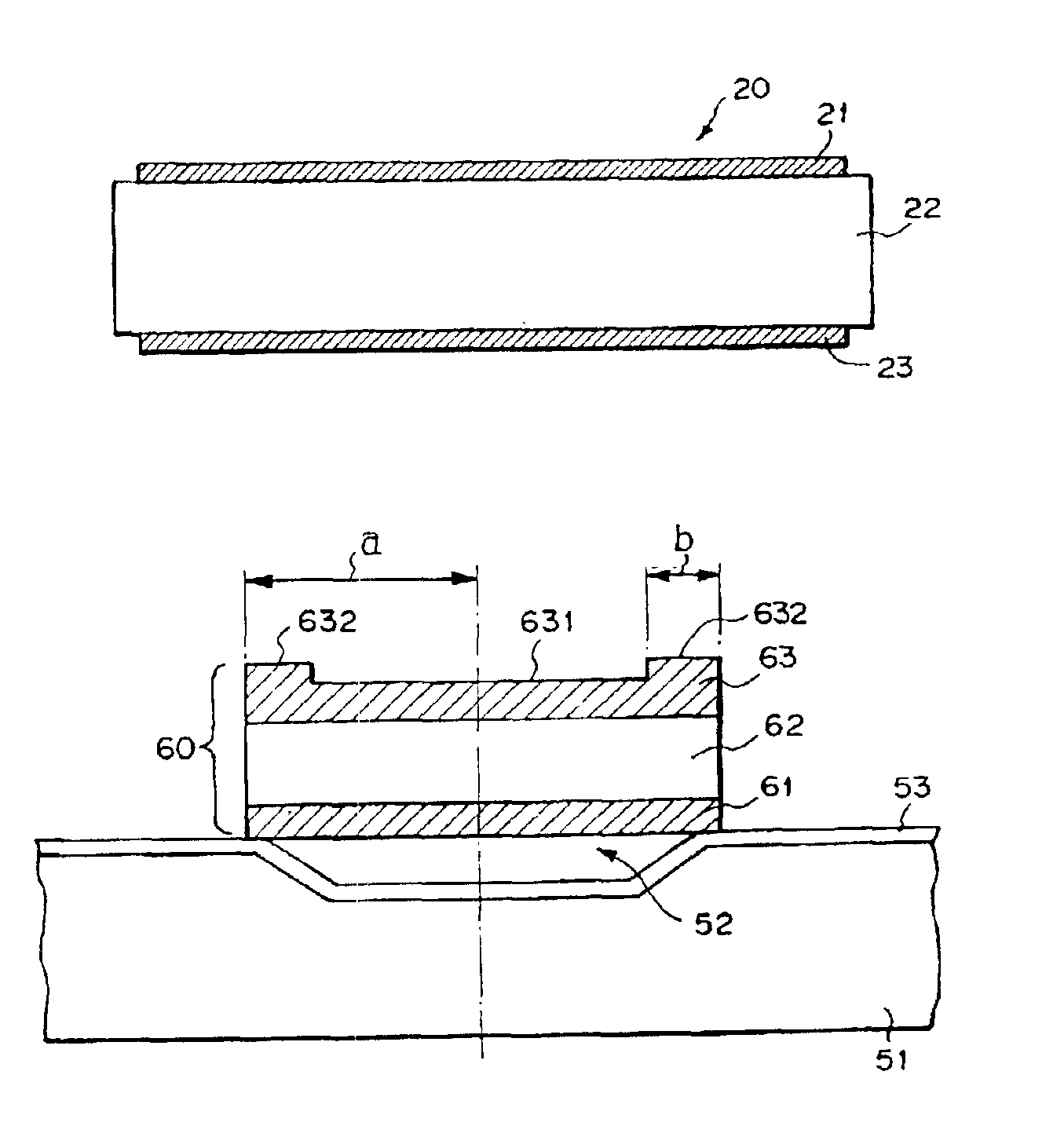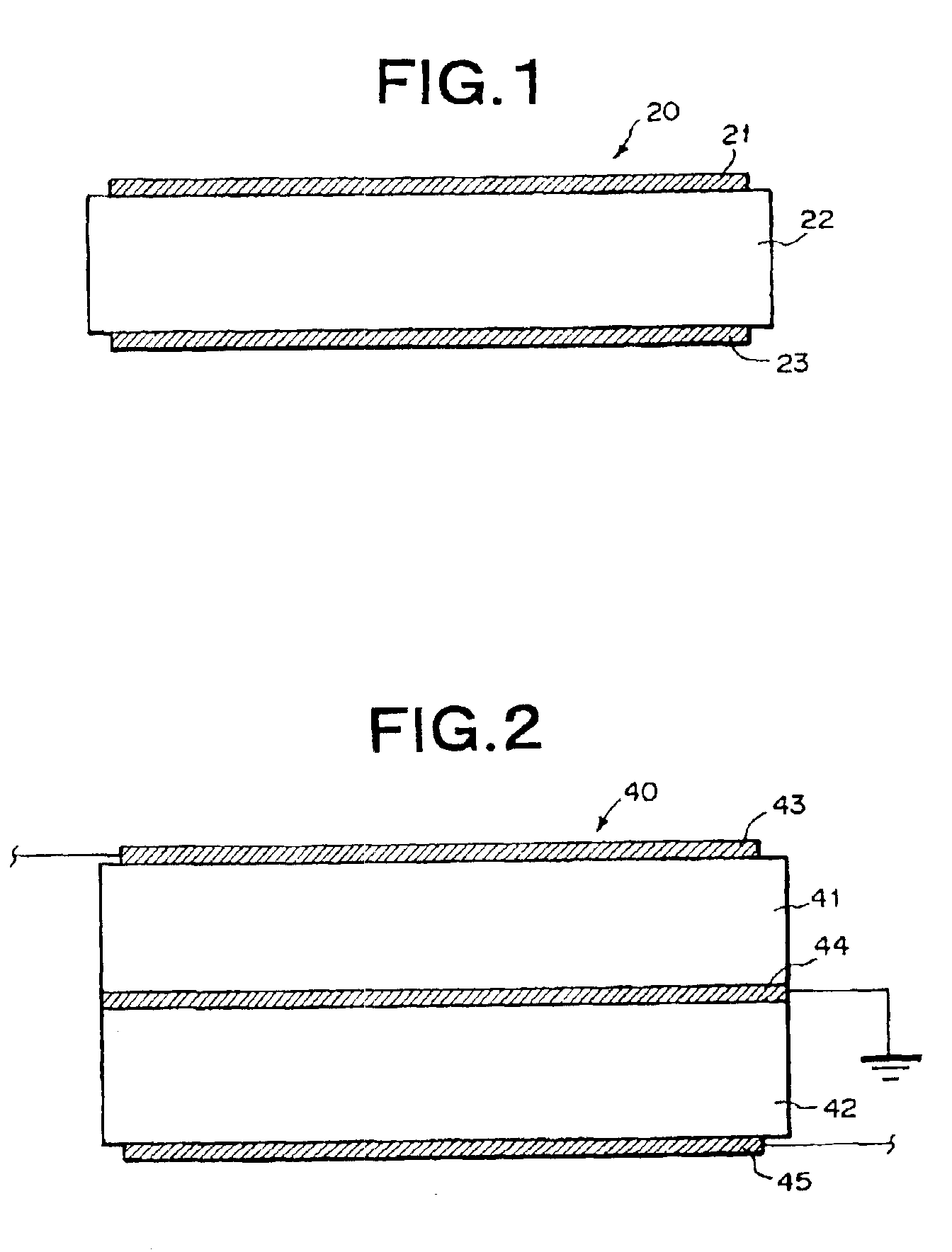Thin film acoustic resonator and method of producing the same
a thin film acoustic resonator and bulk technology, applied in the direction of generator/motor, mechanical vibration separation, instruments, etc., can solve the problems of difficult to increase the achievement amount of final products, difficult to increase the insufficient crystal quality of piezoelectric thin films, etc., to achieve remarkable improvement
- Summary
- Abstract
- Description
- Claims
- Application Information
AI Technical Summary
Benefits of technology
Problems solved by technology
Method used
Image
Examples
example 1
A thin film bulk acoustic resonator was manufactured in the manner as shown in FIGS. 3 to 8.
First, the surface of a Si wafer 51 was coated with a Pt / Ti protection film, and the protection film was etched to have a predetermined pattern for formation of a pit or cavity or recess, thereby forming a mask for etching the Si wafer 51. Thereafter, wet etching was carried out by using the Pt / Ti pattern mask thus formed to form a pit or cavity or recess of 20 μm in depth and 150 μm in width. The etching was carried out with KOH water solution of 5% by weight at a liquid temperature of 70° C. Alternatively, the depth of the pit may be set to 3 μm.
Thereafter, the Pt / Ti pattern mask was removed, and a SiO2 layer 53 of 1 μm in thickness was formed on the surface of the Si wafer 51 by thermal oxidation, thereby achieving such a structure that the pit 52 is formed in the substrate comprising the Si wafer 51 and the SiO2 layer 53.
Subsequently, as shown in FIG. 4, a PSG sacrificial layer 55 of 30 μ...
example 2
An acoustic resonator was manufactured in the same manner as EXAMPLE 1 except that AlN film was used as the piezoelectric film 62 in place of the ZnO film. That is, the piezoelectric layer 62 comprising an AlN film of 1.2 μm in thickness was formed on the lower electrode 61. The formation of the AlN film was carried out by using the RF magnetron sputtering method at a substrate temperature of 400° C. under the condition that Al was used as sputtering target and the mixture gas of Ar and N2 was used as sputter gas. The surface roughness of the AlN film thus formed was measured, and the result was that the RMS variation of the height was equal to 14 nm which was not more than 5% of the film thickness. With respect to the surface of the upper electrode 63, the waviness height at the measurement length of 150 μm was measured, so that the it was equal to 0.2 μm which was not more than 25% of the thickness of the piezoelectric layer 62 and also not more than 0.5% of the measurement length...
example 3
A thin film bulk acoustic resonator was manufactured in the same manner as shown in FIGS. 3 to 5 and FIGS. 9 to 10.
First, a structure shown in FIG. 5 was achieved in the same manner as EXAMPLE 1. However, the surface of the PSG sacrificial layer 55 remaining in the pit 52 was polished with slurry containing fine polishing particles so that the RMS variation of the height of the surface was equal to 5 nm.
Subsequently, as shown in FIG. 9, the insulating layer 54 comprising a SiO2 film of 500 nm in thickness was formed on the substrate by the CVD method so that the surface of the PSG sacrificial layer 55 was also covered by the insulating layer 54. The surface roughness of the insulating layer 54 thus formed was measured, so that the RMS variation of the height was equal to 10 nm.
Subsequently, as in the case of EXAMPLE 1, the lower electrode 61 comprising a Mo film was formed on the insulating layer 54 as shown in FIG. 10. The surface roughness of the Mo film thus formed was measured, ...
PUM
| Property | Measurement | Unit |
|---|---|---|
| thickness | aaaaa | aaaaa |
| height | aaaaa | aaaaa |
| height | aaaaa | aaaaa |
Abstract
Description
Claims
Application Information
 Login to View More
Login to View More - R&D
- Intellectual Property
- Life Sciences
- Materials
- Tech Scout
- Unparalleled Data Quality
- Higher Quality Content
- 60% Fewer Hallucinations
Browse by: Latest US Patents, China's latest patents, Technical Efficacy Thesaurus, Application Domain, Technology Topic, Popular Technical Reports.
© 2025 PatSnap. All rights reserved.Legal|Privacy policy|Modern Slavery Act Transparency Statement|Sitemap|About US| Contact US: help@patsnap.com



